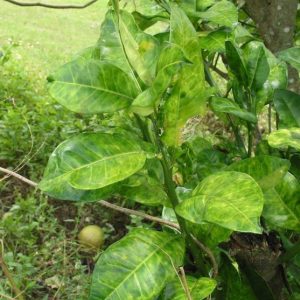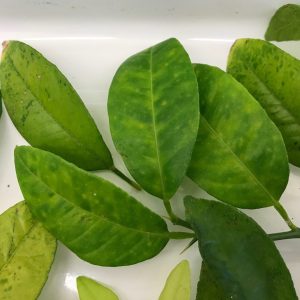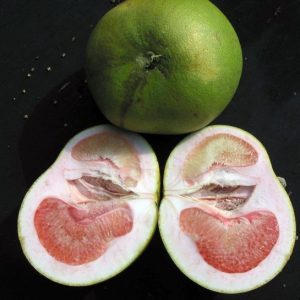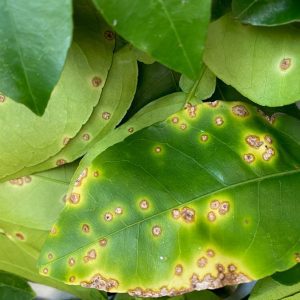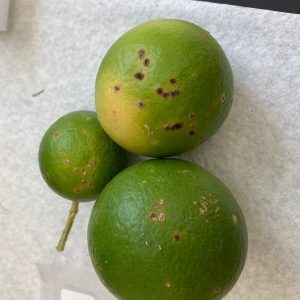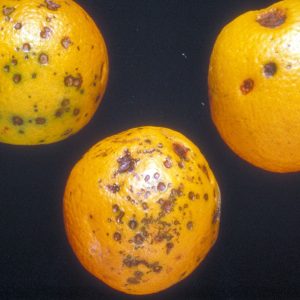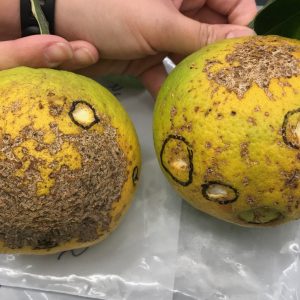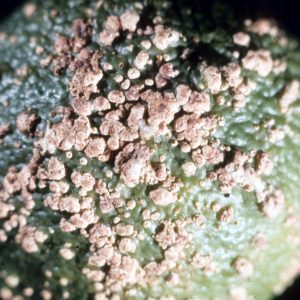Fruits

As a garden plant, citrus provides a unique texture, season-long dark green foliage, a unique fragrance when in bloom, and colorful edible fruit. Learn to care for citrus in your home garden.
The major limiting factors for growing citrus in the home garden are disease and their lack of cold hardiness, which has limited their use in Alabama landscapes to Mobile and Baldwin Counties and the Wiregrass region. Citrus are susceptible to a number of diseases and insect pests, some of which can be damaging to the citrus industry.
Federally Regulated Pests

Figure 1. Citrus nursery stock tag with the nursery name, registration number, and limited permit statement.
Five federally regulated citrus pests have been established in the United States and threaten the citrus industry: huanglongbing (HLB or citrus greening), Asian citrus psyllid (ACP), citrus canker (CC), citrus black spot (CBS), and sweet orange scab (SOS). All of these pests except CBS have been identified in Alabama. Currently, Alabama is under a statewide quarantine for ACP, while Baldwin and Mobile Counties are under an HLB and SOS quarantine. Most recently, Baldwin County is under a quarantine for citrus canker. These regulated pests have significantly reduced the Florida and California citrus industries. Homegrown citrus trees account for the majority of regulated disease detections in the state. They threaten commercial production by acting as a source of disease introductions and reservoirs for pathogens and pest organisms.
These regulated citrus diseases can be highly contagious and spread by wind-driven rain, overhead irrigation, flooding, and human movement. Environmental factors, such as wind and rain, cannot be controlled; however, the spread of pests by humans can be managed by preventing transportation of infected plant material. To help prevent the spread of citrus pests around Alabama and other citrus-producing states, homeowners should only purchase citrus trees that are under a citrus compliance agreement with the state of Alabama. Trees under the agreement will have a tag indicating so (figure 1). If a tag is not present, you can ask to see a copy of the retailer’s agreement. All certified trees should have a tag with the registration number of the nursery at the time of sale. Nursery certification can also be verified with the Alabama Department of Agriculture and Industries (ADAI) at (334) 240-7225.
If you are growing citrus at your home in the southern part of the state, you might occasionally be subject to an inspection by the Alabama Department of Agriculture and Industries. These inspections are routine and important because of the economic damage regulated citrus diseases can cause to the state’s citrus industry. Grower cooperation is important to these inspections to help protect Alabama farms. If a positive occurrence of a regulated pathogen or pest is found on your property, the plants will need to be destroyed. These regulated pathogens may kill or make the plant unproductive over time and serve as a reservoir for spreading the diseases to other citrus on your property or your neighbors’ property. No cure exists for these regulated citrus pathogens at this time. If you suspect that you have a regulated citrus disease, please contact ADAI Plant Protection Division, your local Extension agent, or the Auburn University Plant Diagnostic Lab.
Huanglongbing (HLB)/Citrus Greening
HLB (Candidatus Liberibacter asiaticus) is one of the most destructive diseases of citrus. It is caused by a systemic, phloem-inhabiting bacterium. The early symptoms usually appear on one branch of the tree. Symptoms are characterized by yellowing of normal- sized leaves along the veins and sometimes by the development of a blotchy-mottle coloration. The leaves show a variety of chlorotic patterns resembling those induced by nutrient deficiencies or viruses (figures 2 and 3). Infected trees or branches suffer heavy leaf drop followed by out-of-season flushing and flowering with dieback occurring in severe cases. Infected fruit are small, lopsided, with aborted seeds, and have a bitter taste and unpleasant flavor (figure 4). Many fruits fall prematurely, while those remaining on the tree do not color properly. Affected trees decline to a non-productive state. Citrus greening bacteria are transmitted by the Asian citrus psyllid.
- Figure 2. Mottling symptoms caused by citrus greening. (Photo credit: Florida Division of Plant Industry, Florida Department of Agriculture and Consumer Services, Bugwood.org)
- Figure 3. Chlorotic patterns induced by citrus greening.
- Figure 4. Lopsided fruit caused by citrus greening. (Photo credit: Jeffrey W. Lotz, Florida Department of Agriculture and Consumer Services, Bugwood.org)
Asian Citrus Psyllid (ACP)
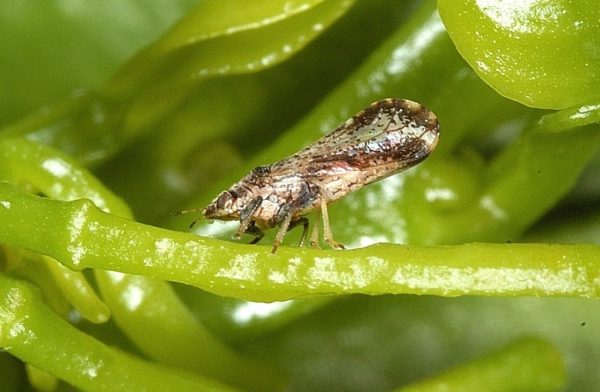
Figure 5. Adult Asian citrus psyllid standing at 30-degree angle. (Photo credit: David Hall, USDA Agricultural Research Service, Bugwood.org)
The adult Asian citrus psyllid (ACP) (Diaphorina citri) is approximately 3 to 4 mm long and stands at a 30-degree angle. In addition to transmitting HLB, ACP can cause damage by feeding on young tender tissue, causing leaf distortion and curling. The psyllid also produces honeydew, which leads to sooty mold infestations. The citrus psyllid produces toxic saliva that arrests cell development in the young tender tissue. ACP reproduces exclusively on young tissue and all life stages can be found there (figures 5 and 6).
Insecticides, such as carbaryl or malathion, can be used when psyllids are observed. Because of the short residual time (weeks) associated with these insecticides, they should be used only when psyllids are observed as they are significantly disruptive to beneficial insects. Soft chemistry insecticides such as oil and insecticidal soaps can provide good control if applied frequently.
This is most effective when applied every 7 to 10 days during leaf flush until new growth is hardened. Citrus may have several leaf flushes throughout the growing season. Horticultural petroleum oils and soaps have a number of advantages over conventional pesticides because they are less disruptive to natural enemies, insects do not develop resistance to them, they have low toxicity to vertebrates, and they break down readily in the environment. These insecticides do not have residual control properties and must come in contact with the psyllids to be effective. Pyrethrins are also contact insecticides with a short residual control window and will also be most effective on new growth; however, pyrethrin’s are toxic to beneficial insects and should be used carefully.
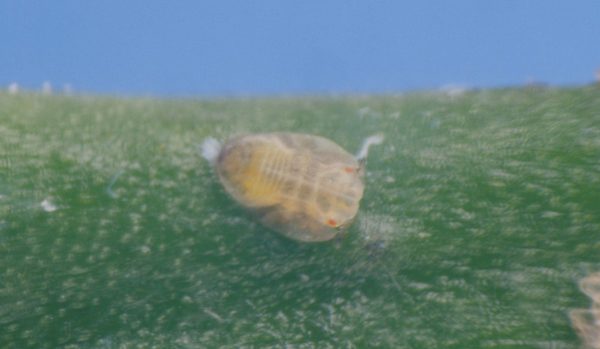
Figure 6. Larval stage of Asian citrus psyllid. (Photo credit: Jeffrey W. Lotz, Florida Department of Agriculture and Consumer Services, Bugwood.org)
Moderate residual control of ACP has been reported using drench applications of imidacloprid. Currently, Bayer Advanced Fruit, Citrus & Vegetable Insect Control is the only labeled imidacloprid product available for homeowner citrus trees for control of ACP. This product requires diluting the concentrate with water and pouring the water around the root zone. See label for specific instructions. Imidacloprid may also reduce the impacts of citrus leafminer. See Extension publication “Citrus Pest Identification and Management Guide” (ANR-2270) on the Alabama Extension website.
When using any pesticide, follow the label instructions to handle the product safely. Safe use of pesticides is important for the applicator, any person that might visit the area, and the environment. Homeowners should also be aware that most insecticides recommended for psyllid control have restrictions on the label because of their impact on pollinators. Planning to control psyllids before the presence of blooms will help reduce the need to apply pesticides during the bloom period. Check the pesticide label for restrictions on the application of a product when trees are in bloom.
Citrus Canker (CC)
Citrus canker, caused by the bacterial pathogen Xanthomonas axonopodis pv. citri, is a serious disease of most citrus varieties. The disease causes necrotic lesions on leaves, stems, and fruit. Severe infestation can cause defoliation, premature fruit drop, twig dieback, and general tree decline. The earliest symptoms on leaves appear as slightly raised, tiny, blisterlike lesions. As the lesions age, they turn tan to brown, and a water- soaked margin appears surrounded by a yellow halo (figure 7). The center of the lesion becomes raised and corky. Lesions are usually visible on both sides of the leaf. Defoliation becomes a problem as the disease intensifies on the tree. Symptoms of citrus canker on twigs and fruit are similar and consist of raised corky lesions surrounded by an oily or water-soaked margin. As the lesions on the fruit mature, they appear scablike or corky (figure 8). Citrus canker is highly contagious and can be spread rapidly by wind-driven rain, lawnmowers, and human movement.
- Figure 7. Foliar lesions surrounded by bright yellow halo caused by citrus canker.
- Figure 8. Fruit lesions caused by citrus canker are raised and corky.
Citrus Black Spot (CBS)
Citrus black spot, Phyllosticta citricarpa, is a serious fungal disease that has the potential to be economically damaging to both processing and fresh fruit. When the disease is not controlled in the grove, up to 80 percent of fruit may be affected. The disease impact comes in the form of blemished fruit and premature fruit drop of heavily infected fruit. Four different symptoms are associated with CBS:
- Hard spot (most common symptom). Small, round, sunken lesions with gray centers and brick red to black margins are observed on fruit (figure 9). Fungal structures may appear as slightly elevated black dots in the center of lesions. The disease appears as the fruit begins to color where light exposure is highest.
- False melanoses. Numerous small, slightly raised lesions that can be tan to brown occur on green and mature fruit (without fungal structures).
- Cracked spot. Large, flat, dark brown lesions with raised cracks in their surface occur on fruit. This symptom is thought to be caused by an interaction with rust mite feeding damage.
- Early virulent spot. Small, reddish, irregularly shaped lesions occur on mature fruit as well as postharvest in storage. Virulent spot is caused by the expansion or fusion of other lesions covering most of the fruit surface toward the end of the season.
- Figure 9. Lesions caused by citrus black spot on fruit are small, round, and sunken with gray centers and dark margins. (Photo credit: P. Barkley, Biological and Chemical Research Institute, Bugwood.org)
- Figure 10. Lesions of sweet orange scab on citrus fruit are warty and cracked, often resembling bird-feeding damage.
- Figure 11. Lesions of the common scab disease on citrus fruit are raised and distinct pustules. (Photo credit: Florida Division of Plant Industry, Florida Department of Agriculture and Consumer Services, Bugwood.org)
Sweet Orange Scab (SOS)
Two scab diseases can affect citrus in Alabama. Citrus scab (also called common citrus scab) is caused by the fungus Elsinoë fawcettii. It has been present in the state for many years and is not a regulated pathogen (figure 11). In contrast, sweet orange scab, which is caused by the closely related fungus Elsinoë australis, was identified in Alabama for the first time in 2017 and is a regulated pathogen. With SOS, the initial scab on fruit will form during the early stages of fruit development and is slightly raised and pink to light brown. Pustules of SOS are more circular and smooth when compared to common citrus scab. As SOS pustules continue to develop, they will become warty and cracked and the coloration can change to a yellowish brown and eventually to a dark gray (figure 10). Scabs are usually dispersed in the same pattern as water being splashed on the fruit. Symptoms can be mistaken for mechanical or bird damage. Common citrus scab will have a greater incidence on foliage when compared to SOS. Sweet orange scab symptoms are not usually evident on foliage.
Healthy Citrus Trees
In general, healthy plants are more resistant to diseases and insects. Proper installation and maintenance are important to produce healthy plants.
Tree Selection
Purchase trees from a certified nursery that has been inspected by state or federal inspectors to confirm that the nursery is producing clean (disease-free) plant material. Citrus trees grown in a certified nursery will have a tag stating the name of the nursery, registration number, the tree variety, and rootstock (figure 1). When purchasing a tree, examine it for any symptoms of pest damage or disease. Trees should have dark-green colored leaves, a smooth trunk, and be well maintained.
Consider choosing varieties based on cold tolerance. The best-suited rootstock for Alabama is trifoliate orange (Poncirus trifoliata). Trifoliate rootstock transfers cold hardiness to the rest of the tree. ‘Rubidoux’ and ‘Flying Dragon’ are two widely available selections. Plants grown on ‘Rubidoux’ will mature to the standard size, but ‘Flying Dragon’ has dwarfing characteristics that make it ideal for the home garden. Often, citrus grown for retail purchase are budded onto Sour Orange and the ‘Carrizo’ rootstock. Sour Orange and ‘Carrizo’ are fast growing and preferred by nursery growers; however, they do not provide any cold hardiness traits and should be avoided in Alabama.
Choose plants that are 5/8 to 1 inch in diameter and 2 to 4 feet tall. Look for trees that have 3 to 4 upward- growing side branches. These branches will eventually become “scaffold branches” and will support the canopy. Avoid trees whose branches have sharp crotch angles that will be weak and break at the trunk when under a heavy fruit load.
Planting and Site Selection
Citrus can be planted any time of year, although planting in early spring is recommended to reduce the risk of freeze damage. A planting location in full sun on the south side of the home is typically warmer, though citrus can be grown (less productively) under shade. Remove any weeds or old plant material from the area. Dig the planting hole only as deep as the tree’s root ball. When inserting the tree into the ground, the soil line of the tree should be level with the tree’s root flare (the topmost root of the tree). Do not plant the tree any deeper than it was in the pot. Fill the remaining area with native soil.
Irrigation
Watering a citrus tree is important to its establishment and growth. Between March and June, the tree should be watered twice a week (1 to 2 gallons) if rainfall is insufficient. The tree should never become wilted, as this inhibits establishment and growth. Wilting in the tree is expressed by cupping of the leaves and a dry appearance.
Fertilization
Citrus are considered heavy feeders and can handle high fertilizer rates. A soil test from the Auburn University Soil, Forage & Water Testing Laboratory can help determine the appropriate amount of fertilizer and lime to apply each year. Many different fertilizer formulations are available for use on citrus trees. Fertilizer formulations such as 6-6-6 or 8-8-8 (for young trees) and 10-10-10 (for mature trees) are suggested, but other complete fertilizers can also be used. The total annual recommendation should be split evenly into three applications: early bud break (late February through March), fruit swell (May), and when fruit reaches 1 inch in diameter (June). This can generally be simplified to Easter, Mother’s Day, and Father’s Day. The risk of cold damage increases if nitrogen applications are made from September to February. Unless an alternative recommendation is given with a soil test report, use a complete fertilizer with micronutrients. For new plantings, spread fertilizer 30 inches out from the center. For established trees, a general rule of thumb is to spread fertilizer twice the diameter of the canopy. Never apply fertilizer next to the trunk. Citrus can perform well under soil pH ranging from 5.5 to 7.0. Citrus tend to alternate the fruit they bear (heavy fruit load one year and a light load the next). Proper fertilization will help reduce alternate bearing. Some symptoms of citrus greening can often be confused with nutritional disorders. Maintaining proper fertilization will also help to distinguish between nutrient deficiencies and disease.
Pruning
Remove suckers from the base of the young trees to prevent interference with tree development. Mature citrus trees do not require training and pruning for production the way other fruit trees do. Prune lightly to shape the tree or to remove dead or damaged limbs. Excessive pruning usually results in reduced fruit production, vertical shoots called water sprouts, and suckers. As a general rule, do not remove more than a third of the canopy during the light pruning.
Patio Citrus
An option for central and north Alabama gardeners interested in growing citrus is patio citrus, which are grown in containers. Citrus tolerate being confined to a container quite well, likely more so when growing a dwarfing selection such as ‘Flying Dragon’. The aesthetic attributes of citrus foliage alone make container-grown plants an excellent foliage plant. Container-grown citrus allow gardeners to move the plant indoors in case of an imminent freeze. Be aware that citrus grown in the ground have the advantage of the earth to protect and insulate the roots. Container-grown plants do not have this advantage and roots can easily be damaged by even a mild freeze. Generally, a 10-gallon or larger pot (with drainage holes) is sufficient. Larger containers will allow for larger trees and a longer time period before repotting or replacement. Eventually, the plants will become root bound and outgrow the container. At this point, you have the following options: buy a new plant, repot the plant into a larger container, or significantly prune roots and shoots and repot in the same size container. When growing in a container, use well-drained potting soil and plan on watering the plant almost every day during warm weather. Use a controlled-release fertilizer such as a 3- to 4-month fertilizer in the spring and again in late summer. Patio- or container-grown citrus may offer more opportunities for less cold hardy citrus types.
For a detailed description of all citrus pests of Alabama, both regulated and unregulated, see Extension publication “Citrus Pest Identification and Management Guide” (ANR-2270) on the Alabama Extension website.
 Kassie Conner, Extension Specialist, Plant Diagnostic Lab; Jeremy Pickens, Assistant Extension Professor, Commercial Horticulture; John Olive, former Director, Ornamental Horticulture Research, Jacob Kelley, Regional Extension Agent, Commercial Horticulture; and Jack Lecroy, Regional Extension Agent, Home Grounds, Gardens, and Home Pests, all with Auburn University
Kassie Conner, Extension Specialist, Plant Diagnostic Lab; Jeremy Pickens, Assistant Extension Professor, Commercial Horticulture; John Olive, former Director, Ornamental Horticulture Research, Jacob Kelley, Regional Extension Agent, Commercial Horticulture; and Jack Lecroy, Regional Extension Agent, Home Grounds, Gardens, and Home Pests, all with Auburn University
Revised February 2023, Citrus Tree Care for the Home Gardener, ANR-2854


